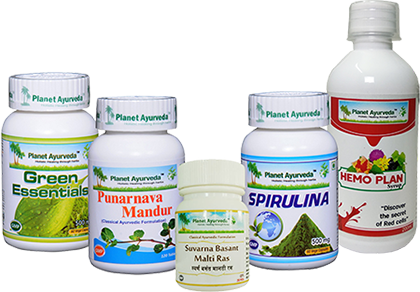Treatment of Sideroblastic Anemia with Ayurveda
Abstract
Sideroblastic anemias are referred to as a group of diverse anemias that are presented as increased ferritin, serum iron, and transferrin saturation. There are two main common features in Sideroblastic anemias which is the presence of normoblasts containing excessive accumulated iron in the mitochondria, termed as ring sideroblasts, and impairment in the biosynthesis of heme.
Introduction
However, usually people are aware of the type of anemia where there is a lack of iron inside the cells which causes insufficient production of hemoglobin that is responsible for carrying out the oxygen in the blood. Sideroblastic anemia is a completely different case from the former on. There is a lot of iron in your cells which is due to the production of abnormal red blood cells by the bone marrow which eventually leads to improper production of the hemoglobin. There occurs pathological accumulation of iron in the mitochondria of the erythroid precursors. Ring sideroblasts are formed due to iron-laden mitochondria surrounding the erythroblast nuclei. Sideroblast anemia can result in certain complaints like fatigue, malaise, weakness, and even much more serious complications. It is a group of blood disorders but one thing in common is that all of them cause difficulty to bone marrow in the production of healthy and normal red blood cells. Men are more prone to congenital sideroblastic anemia than women while acquired one occurs equally in both.

Types Of Sideroblastic Anemia
Sideroblastic anemia can be of two types either Acquired or congenital.
- Acquired Sideroblastic anemia – This type of Sideroblastic anemias are more common and can be reversed easily as compared to the congenital one. The exact cause of this anemia is not known however some of the risk factors are prolonged intake of certain drugs and intake of alcohol might also play the role. Other factors that might be responsible for causing Acquired sideroblastic anemias are certain immune system disorders, metabolic disorders, tumors, or prolonged contact with some of the toxic chemicals. It is usually found to be linked with a myelodysplastic syndrome that results in hypochromic anemia. These types of Anemias are diagnosed usually in Adulthood. The deficiency of copper or Vitamin B6 is also linked with this ailment.
- Congenital Sideroblastic anemia – This type of Sideroblastic anemia is rare and less common as compared to the acquired one and also difficult to treat comparatively. They are usually diagnosed in infancy or childhood. X-linked congenital sideroblastic anemias are the most common of them where occur a mutation in the gene involved in the biosynthesis of the heme. Usually, the red blood cells ate hypochromic and microcytic. This results in the body absorbing more and more iron of the food to compensate for the hemoglobin production which leads to the accumulation of too much iron in the cells.
Causes
The exact cause is unknown however some of the related factors are found. In hereditary Sideroblastic anemia there usually occurs mutation in the gene that is found on the X chromosome and is responsible for the production of normal hemoglobin. However, in acquired sideroblastic anemia several factors are linked to it like hypothermia, excessive alcohol intake, an overdose of zinc, and deficiency of minerals and vitamins like copper and vitamin B 6. Other than this, certain medications like drugs for tuberculosis, antibiotics, and progesterone are found to be triggering factors for Sideroblastic anemia.
All these factors collectively lead to impairment in the formation of heme which eventually leads to the conversion of iron into protoporphyrin IX causing the production of sideroblasts.
Signs and Symptoms
Signs and symptoms of sideroblastic anemia mimic to those of other anemias like malaise, fatigue, weakness, pain in the chest after exertion, difficulty in breathing, skin color turns to pale of hands and arms, pale nails, and enlargement of the liver or spleen, increased heart rate (Tachycardia), headaches, and palpitations.
Diagnosis
It might be tricky and difficult to diagnose Sideroblastic anemia due to the huge resemblance of its signs and symptoms with other types of anemias. Sideroblastic anemia is a slowly progressive disorder and usually, the patient remains unaware of it. Initially, it will be detected in blood tests in which Complete blood count will be abnormal and hence patient will be advised for a peripheral smear. In peripheral smear, the ringed sideroblasts will be revealed. Bone marrow biopsy will be confirmed for this diagnosis.
Treatment
The general conservative Treatment of Sideroblastic anemia includes therapy of Vitamin B6, injections of Desferal for removal of a high amount of accumulated iron from the red blood cells. In some cases, even Bone marrow transplant or stem cell treatment is suggested.
However, the Ayurvedic treatment offers the natural management of the disease through herbs and natural methods. Ayurveda is the science of life that originated in India and is now being used in many parts of the world. It is the most natural and convenient mode of treatment in which diseases are treated as per the predominant dosha in a particular person.
Treatment By Planet Ayurveda
Planet Ayurveda has been offering numerous herbal products for the treatment of various acute and chronic diseases. It is a growing and emerging big name in the field of Ayurveda pharmaceuticals. Sideroblastic anemias as well as Planet Ayurveda offers a combination of herbs that help to manage and naturally treat the disorder. The herbal products offered are prepared from pure and best quality of herbs.
1. Green Essential
These are the polyherbal capsules prepared from Wheatgrass, Spirulina, Green tea, Amla, and Grapeseed. Green essential capsules are rich in vitamins and minerals which help in the formation of healthy red blood cells.
Dosage- Take 1 capsule twice daily after meals with plain water
2. Spirulina capsule
These herbal capsules are prepared from the blue-green algae named Spirulina. It is full of minerals, vitamins, and other healthy nutrients and known as a powerhouse of healthy properties. It is a naturally rich source of Vitamin B12 and other vitamins which helps in the formation of hemoglobin and healthy red blood cells.
Dosage- Take 1 capsule twice daily after meals with plain water
3. Punarnava Mandur
These herbal tablets are well known for treating anemias and other blood-related ailments. It is prepared from Punarnava, Shunthi, Pippali, Maricha, Amalaki, Haritaki, Vidanga, etc.
Dosage- Take 2 tablets twice daily after meals with plain water
4. Suvarna Basant Malti Ras
These amazing therapeutic tablets are prepared from Swarna bhasma, Mukta bhasma, Shuddh hangul, Maricha, and Kharpar bhasma. These tablets help to treat the anemias and their associated complaints owing to the properties to fight low vitality, infections and also helps in the formation of healthy RBCs.
Dosage- Take 1 tablet twice daily after meals with plain water
5. Hemoplan Syrup
As the name suggests this syrup is formulated to fulfill the deficiency of hemoglobin in the body and treat anemia. It is also a natural blood purifier. Hemoplan syrup is prepared from herbs like Manjishtha, Shatavari, Ashwagandha, Gorakhmundi, etc.
Dosage- Take 2 teaspoonful twice daily after meals with plain water
Conclusion
Chronic and complex diseases like Sideroblastic anemia can be treated very well by natural remedies and herbal treatment. These remedies have a therapeutic effect that eradicates the disease from root cause without causing any side effects even if taken for long term.





